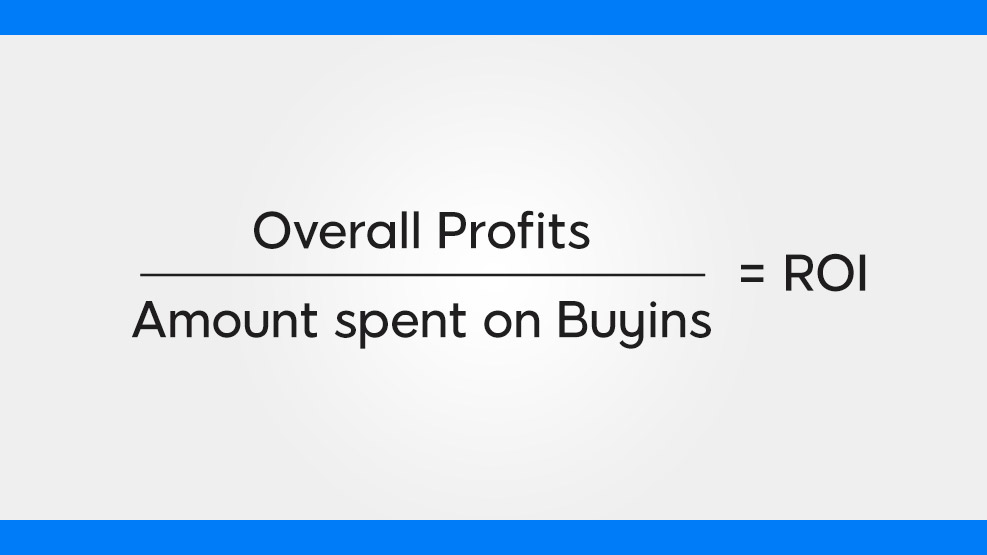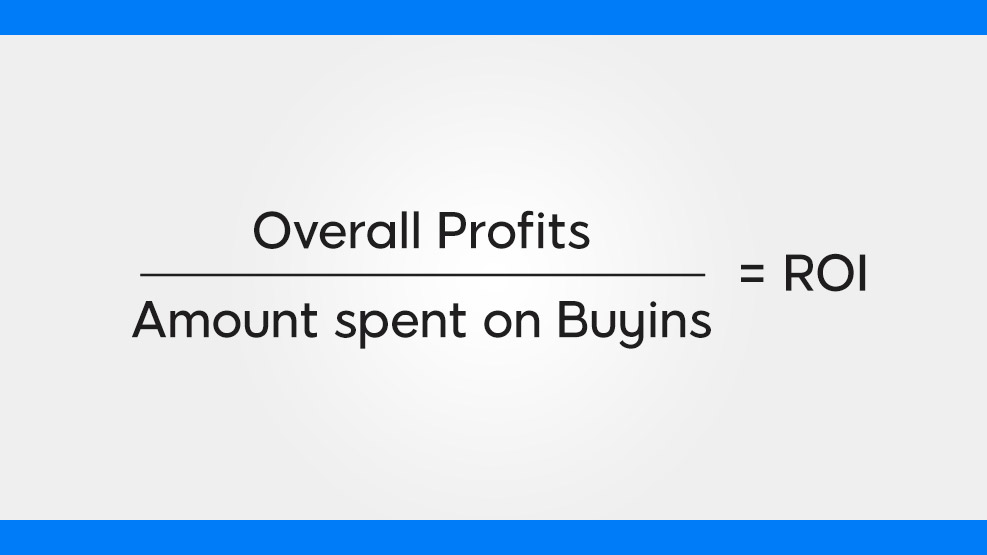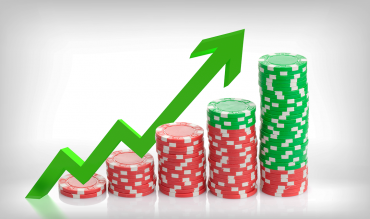ROI stands for “return on investment” and is essentially a tournament player’s way of keeping track of results. Perhaps we are familiar with the idea that cash game players keep track of their winrate using bb/100 – the amount of big blinds won per 100 hands on average.
Unfortunately, this would not work very well as a measure of winrate for a tournament player. Why? Because it would be possible for them to have a positive bb/100 winrate but still lose money overall, due to the increasing blind levels. It’s possible to win more bbs than our opponents in a sit-n-go or tournament, but still not finish on top.
So tournament and sit-n-go players clearly need a different method of keeping track of their winnings. This is where ROI comes in.
Table of Contents
How to Calculate ROI
The formula for ROI is pretty straightforward.

*as a decimal – multiply by 100 for ROI%
Deducting our tournament buyins from our tournament winnings will give us our overall profit. In other words, we have to subtract our buyins from our overall winnings to calculate our net profit.
Hint - The result will be in decimal format and should be multiplied by 100 to give our ROI as a percentage (ROI%).
Let’s practice with a couple of examples to make sure the formula makes sense.
Example 1. We have played 100 $1 sit-n-goes. Our gross winnings are $256 (not profit, gross winnings). What is our ROI?
See if you can answer the question here by calculating ROI. Then confirm your answer with the calculation below.
Hint – When we talk about “gross profit” we are talking about all the money we have won without considering our losses/buyins.
Answer - The first step is to calculate profit. We’ve probably made this a little tougher than it needs to be. If we knew our starting bankroll, we could just check our current bankroll and figure out our net profit.
Anyway, in this scenario we have invested $100 in buyins, (100 * $1). So, if our gross winnings are $256, this must mean our net profit is $156.
Overall Profit = $156
Amount spent on Buyins - $100
156/100 = 1.56
So remember that this value is our ROI expressed as a decimal. We can multiply this by 100 if we prefer to see our ROI expressed as a percentage. In this case, our ROI% would be 156%.
So essentially, every time we play one of these $1 sit-n-go tournaments we are making 156% of our buyin on average, i.e. $1.56. This result is an absolute huge return on investment. A reasonable ROI would be closer to 10% over a large sample.
Example 2. We play 1000 $5 sit-n-go's with an ROI of 13%. What is the overall profit? What are our gross winnings?
Gross winnings are pretty much useless, as players we only care about our net profit. But calculating gross winnings will help to make sure we understand the ROI formula and that we know the difference between gross winnings and overall (net) profit.
Again, see if you can answer the question and then confirm your answer with the calculation below.
Answer – If we have an ROI of 13% over this sample it essentially means that for every $5 we invest we are making an additional 13% of our $5 buyin. So, what is 13% of $5?
$5 * 0.13 = $0.65.
So for each of the 1000 tournaments we have played, we have made $0.65 on average. So what is our total profit?
$0.65 * 1000 = $650
However, our gross winnings will include the amount we spent on the buyins. In this case, we spent $5000 on buyins (1000 * $5). So our gross winnings would have been $5650 which means our gross losses would, therefore, be $5000 - given that we know our net profit is $650.
Sometimes, when doing maths, it can be worthwhile to do a little reverse engineering just to help us check our numbers. Let’s see if we can input the numbers into the ROI formula to arrive back at our original 13% ROI

So, overall profits were $650.
We spent $5000 on buyins.
Our ROI expressed as a decimal is 650/5000 = 0.13
We can multiply this by 100 to arrive at our original ROI of 13%.
ROI and Variance
Perhaps one of the reasons we had an extremely high ROI value in the first example was that the sample size was very small. We had only played 100 sit-n-go tournaments.
This number might seem like a lot, but the truth is, if we have played less than about 200 sit-n-go's, our ROI can be wildly inaccurate. Swings in sit-n-goes can last over several hundred tournaments.
This issue is complicated even further when we start playing larger field events such as MTTs. The more participants in each of the tournaments we register for, the higher the variance, and the larger the sample size required to arrive at a somewhat accurate ROI.
Maximising ROI
In many cases, we would like to maximise our ROI when playing poker tournaments.
We can maximise our ROI by -
- Playing on networks with low tournament fees
- Looking for networks with soft tournament games
However, ROI is not the most important factor for a tournament player. A high ROI might give us bragging rights, but for professional poker players the most important metric is typically $/hr (dollars per hour).
We might find, for example, that if we play faster format sit-n-go's (faster blind structure and blind levels, etc.), our ROI is lower. But, if we are making a larger amount of dollars per hour playing those formats, do we really care that our overall ROI is lower?
The same can be said for playing higher limit sit-n-go's. It’s true that we can maximise our ROI by playing lower limit sit-n-go's, but if our hourly rate is higher in higher stakes games. Perhaps we shouldn’t care in the slightest that our ROI is a little lower.
So, ultimately ROI can be used as a good rough guide for determining how we are doing on the tournament scene. But, we must also remember that ROI is heavily affected by variance. In many cases, it won’t be the most important metric in determining success for a tournament player.


